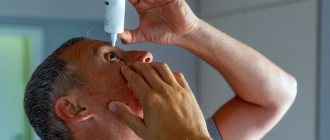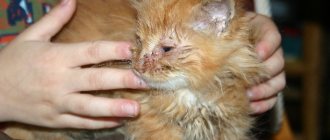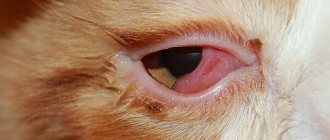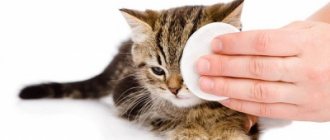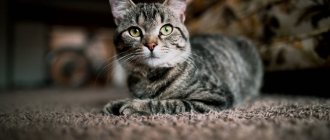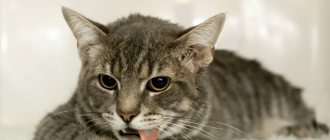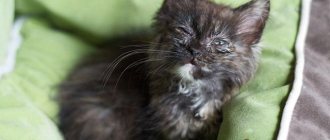Cats, like humans, regularly produce tear fluid. It prevents the eyeballs from drying out and helps remove foreign particles. In a healthy cat, lacrimation is invisible to others. But if fluid is leaking heavily from your pet’s eyes, this may be an alarming sign that indicates the development of a serious pathology. Let's find out what causes the excessive secretion of tears, and in what cases the help of a veterinarian is necessary.
The mechanism of lacrimation in cats
The production of tears is a protective function of the body. Liquid is necessary not only for removing foreign objects and moisturizing the eyeball. It also prevents the penetration of harmful microorganisms and protects the eyes from aggressive environmental influences.
Causes of lacrimation may be:
- The natural secretion of tears is normally a clear liquid that flows in small quantities from a cat's eyes.
- Individual characteristics. Some cat breeds are predisposed to excessive tearing due to their unusual skull shape. This factor does not relate to the symptoms of diseases.
- The presence of pathologies in the cat’s body. In this case, tears appear against the background of other signs of the disease.
The little kitten's eyes are running almost constantly. The baby sleeps a lot, and when waking up, tear secretion mechanisms are activated in order to remove stagnant fluid from the ducts after sleep, wash the mucous membrane and remove small debris from its surface.
The eyes of cats of the brachycephalic group runny. It includes representatives of Persians, Exotics, Himalayans, Selkirk Rex, British Shorthairs and Scottish Folds. All of them differ in a common feature of the structure of the skull - its width is greater than its length. Because of this, the nasolacrimal ducts are shortened, and in Persian longhairs they are also twisted. In a healthy cat, with normal tear production, dirty wet paths do not form from the pupil to the nose; wet fur retains its natural color and does not stick together. But such cats need additional hygiene procedures - the eyes must be regularly cleaned of crusts and carefully monitor the level of tear secretions.
Symptoms
The pathological nature of lacrimation can be determined by several signs. The following symptoms are usually present:
- asymmetry of the pupils;
- swelling and redness of the eyes;
- excessive sunken or bulging eyeball;
- purulent discharge;
- change in iris color;
- irritated cornea;
- the formation of a painful crust or cloudy film on the visual organs;
- presence of injuries (bruises, scratches, bleeding);
- the animal squints;
- photophobia (the cat hides in the dark corners of the apartment).
Purulent discharge from a cat's eyes
Excessive lacrimation (epiphora) in cats
Pathological secretion in the specialized literature is designated by the term “epiphora”. A characteristic difference from natural tears is the brown or greenish tint of the liquid, which leaves a dirty trail from the eyes to the nose. “Glasses” form around the pupil, the hair where the discharge gets in can stick together and fall out, and irritation appears on the skin. Epiphora is often accompanied by additional processes: redness of the eyelids, inflammation of the cornea, and the development of infections. Tears flow from the eyes, which the cat tries to remove with its paws.
Epiphora can be caused by various diseases. In the simplest cases, we are talking about improper hair growth on the face, too thick or curled eyelashes. The hair gets on the mucous membrane, irritates it and causes a natural reaction of the body in the form of lacrimation. Fluid is constantly leaking from the cat's eye. At the same time, the animal becomes nervous and blinks frequently, which involuntarily increases the formation of new fluid.
Another very primitive reason for tears is untimely treatment for internal and external parasites. From worms, cats “cry” in the same way as with inflammation of the cornea or chlamydia.
Some cat breeds are prone to drooping eyelids. This eye pathology is often diagnosed in Persians, Exotics and Himalayans, Maine Coons and in the hairless group. In childhood, the disease is caused by genetic inheritance, and in adulthood it begins due to age-related changes in tissues. The eyelid rolls up and irritates the mucous membrane of the eye. Sometimes everything goes away in a mild form and only periodically causes the animal discomfort, which is accompanied by copious secretion of tears. In other cases, the consequences are much more serious - conjunctivitis, ulcers, swelling.
Without exception, all lesions in the eye area in a cat cause epiphora. If your cat's eye is leaking at any sign, you cannot treat it at home. It is necessary to urgently take the pet to a veterinary clinic, where an ophthalmologist will make a diagnosis and prescribe a therapeutic course. In some cases, surgical intervention is required - it happens that due to lacrimation, animals completely lose their vision.
Important! The release of tears from a cat's eyes is always the body's response to irritation. Therefore, epiphora is not considered as a separate symptom.
What to do at home
There are many possible causes of epiphora and it is impossible to establish the true one on your own. Watery eyes can be a symptom of many diseases. Therefore, at the first signs you need to consult a doctor and, if possible, an ophthalmologist.
You can wash the area around your cat's eyes yourself only if there are minor tears, which is something that owners of Persian and exotic breeds often have to do. And also in case of contact with chemicals, when it is dangerous to hesitate. For treatment, you should not rinse your eyes.
If you need to wash your cat's eyes, it is safe to do so using the following means:
- Saline solution (sodium chloride).
- Chamomile infusion (1 filter bag or tablespoon of herb per glass of boiling water). Use the infusion when it has cooled.
- Chlorhexidine. The pharmacy sells 0.05%, so it needs to be diluted to 0.01% saline. To do this, draw 4 ml of chlorhexedine into a 20 ml syringe and then 16 ml of saline solution.
- Boric acid solution (2%).
- Boiled water.
There are also special preparations on sale. Here are some of them:
- PRETTY EYES lotion (Shaws) for animals with white fur.
- Ophto-Lavas solution (Vetoquinol company).
- Excel Tear Stain Remover Liquid 8 in
- Eye Envy solution.
- Gel Soin des Yeux Felin (Hery company).
- Mo more tear stains lotion (Show Tech), etc.
Eye drops from a human first aid kit should not be used for rinsing.
The main reasons why a cat tears
The process of formation and elimination of tears consists of two stages:
- The lacrimal gland produces a transparent substance that consists of water, protein, mineral salts and lysozyme (a substance with a bactericidal effect). The accessory gland of Harder produces an oily mass. These secretions pass through the conjunctiva and ducts. It doesn’t matter whether the cat’s tears flow from one eye or two – the visual organs will have to be treated comprehensively.
- Fluid is removed from the eyes through lacrimal openings - small natural “pumps”. They are located in the area of the lacrimal lake, in the inner corners of the eyes. From here, the fluid is pumped into the lacrimal sac and moves towards the cat's nasal and oral cavity. On the surface of the nose, tears evaporate, and in the mouth they mix with saliva and are swallowed.
Any disruption of this process causes epiphora. In this case, you need to show your pet to a specialist. The veterinarian prescribes the appropriate therapeutic course after establishing an accurate diagnosis.
Impaired tear flow in cats
A disruption in the outflow of tears, which causes a cat’s eyes to run, is caused by:
- absence of lacrimal openings – occurs due to poor genetics, but is extremely rare in cats;
- reduction in the diameter of the lacrimal opening and its insufficient throughput;
- pathology of the eyelid (entropion or eversion) – the lacrimal punctum does not reach the area where excess fluid is collected;
- compressed lacrimal (nasolacrimal) tubules;
- fusion of the walls of the tubules, which leads to internal obstruction of the tear fluid - appears due to inflammatory processes (conjunctivitis);
- thickening of secretions and formation of plugs inside the ocular excretory tract;
- inflammation;
- mechanical injuries in the eye and nose area;
- infections and allergies in cats;
- neoplasms.
Increased tear production in a cat's eyes
Very often, a cat's eye flows not due to a malfunction in the tear outflow system, but due to its too active reproduction. The reason for this can be either the ingress of foreign objects or internal inflammatory processes:
- irritation of the mucous surface of the eye by hairs or cilia;
- diseases affecting the eyelids;
- inflammation of the mucous membrane of the eye caused by allergies, viral or bacterial infections, or dirt;
- inflammation of the cornea;
- glaucoma - increased pressure inside the organ of vision;
- inflammation of the iris or choroid;
- neoplasms that provoke irritation.
Important! With certain diseases, only one eye of a cat leaks. This immediately indicates the beginning of an infectious infection, in which the process will subsequently spread to the other side and will develop further.
Clinical manifestations
If a cat's eye is leaking, you need to do an initial examination and determine the degree of threat to health.
The following signs represent danger:
- constant moistening of the fur in the area of the inner corner of the pupil;
- hair dyeing brown and hairs sticking together tightly;
- the appearance of dermatitis - inflammatory processes on the skin in the area of contact with secretions;
- the cat blinks frequently, rubs its face with its paws, tries to avoid bright light and hides;
- The pet experiences discomfort, itching, and scratches moist areas.
It is not recommended to treat your cat’s running eyes at home on your own. It is best to immediately contact a specialized veterinary clinic.
Important! Before going to the doctor, you do not need to wash your cat’s eyes and remove accumulated discharge. This will change the overall picture of the disease and make it more difficult to make a fair diagnosis.
Methods for diagnosing diseases if a cat's eyes are running
A leak in a cat is most often diagnosed by using a contrast dye test. It is dropped into the eyes, waited for 10-20 seconds and the movement of fluid throughout the outflow system is checked. During the normal process, colored tears come out in the nose or mouth along with saliva. Otherwise, the place where the natural flow of fluid has been stopped is determined.
In case of purulent discharge, before treatment, the cat is prescribed a bacteriological examination, and pathology of the nasal (or paranasal) sinus requires rhinoscopy with a biopsy.
Sometimes kittens have watery eyes due to sinus, bone, or jaw injuries. In this case, radiography is performed.
Signs of pathology
The first symptom of the development of a disease or various disorders is a change in the nature of the discharge. It changes color, consistency, and an unpleasant odor may appear. In this case, the development of the disease in the animal can be suspected.
Brown mucus in the eyes of a Persian cat
Depending on the physical characteristics of the fluid, a specialist will be able to determine the type of pathology. To make a more accurate diagnosis, an examination will be required. The main signs of pathological exudate that goes beyond the norm include:
- purulent discharge of beige, yellow, light brown or light green color (with or without an unpleasant odor);
- cloudy liquid with a thick consistency;
- milky mucus;
- brown or red exudate;
- a significant increase in the amount of mucus secreted with reddening of the proteins, accompanied by frequent blinking.
Important! Identifying the cause of the disease and eliminating it must be entrusted to a specialist. If not treated correctly, the disease will progress, which can lead to loss of vision.
Treatment options
After making a diagnosis, the ophthalmologist decides what to do and how to treat the cat. In the simplest scenarios for the development of epiphora, this can be done regardless of other diseases:
- if foreign objects are detected, they are removed - therapy involves the use of eye drops and ointments;
- getting rid of curled eyelashes in a cat is done using electrolysis or cryosurgery (low-temperature effects on the area);
- Lacrimal punctal stenosis is corrected surgically.
Most often, a one-time intervention is enough to completely rid the cat of the disease. Relapses are extremely rare and repeat procedures are almost never required.
Important! If epiphora in a cat has developed due to an infectious disease, the veterinarian will first prescribe treatment for the underlying disease, and only then eliminate the residual effects of lacrimation.
Prevention
There are a number of preventive measures that can help reduce the risk of tearing in cats. List of recommendations:
- timely vaccination;
- systematic deworming;
- maintaining an optimal level of humidity in the room;
- compliance with the rules of hygienic care (treatment of the visual organs, combing hair, bathing);
- establishing a proper diet with sufficient vitamins and microelements;
- regular trimming of nails (to prevent accidental injury to the eyes).
You should never treat a cat without first consulting a specialist. This can lead to negative consequences for the pet's health.
